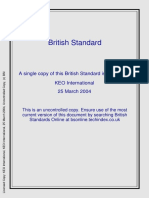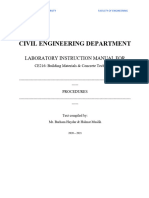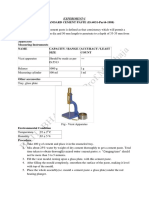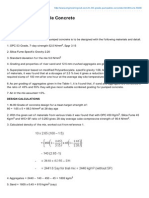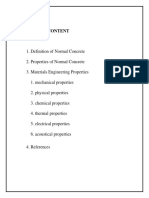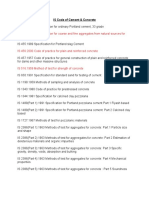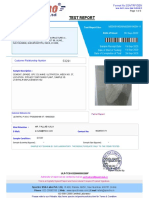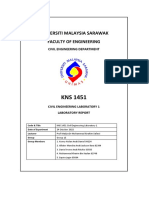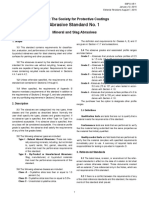Lab Manual Concrete
Uploaded by
MariYam AliLab Manual Concrete
Uploaded by
MariYam AliSUBMITTED TO: ENGR.
RIZWAN
MUAAZ ANUS
BSCE-01143050 PRC-2 (LAB MANUAL)
SECTION – B-1
CIVIL ENGINEERING DEPT .
THE UNIVERSITY OF LAHORE
PRC-2 (LAB MANUAL) MUAAZ ANUS -BSCE-01143050
TABLE OF CONTENTS
EXPERIMENT NO. PAGE NO
EXPERIMENT 1……………………………………………………………1
EXPERIMENT 2………………………………………………....................9
EXPERIMENT 3……………………………………………………………14
EXPERIMENT 4……………………………………………………………17
EXPERIMENT 5…………………………………………………………....20
EXPERIMENT 6………………………………………………….…...........24
.
EXPERIMENT 7……………………………………………………………26
EXPERIMENT 8……………………………………………………………29
EXPERIMENT 9………………………………………………....................35
EXPERIMENT 10…………………………………………………………..38
THE UNIVERSITY OF LAHORE 1
PRC-2 (LAB MANUAL) MUAAZ ANUS -BSCE-01143050
EXPERIEMNT NO 1
CONCRETE MIX DESIGN
OBJECTIVE OF CONCRETE MIX DESIGN
To determine the most economical and practical combination of available
materials (i.e. aggregates, cements, water, admixtures, etc.)
To produce a concrete that will satisfy the performance requirements which
includes workability, durability and strength.
APPARATUS
Concrete mixer
Weighing balance
Cement
Sand/Fine Aggregate
Crush/Coarse Aggregate
Water
Moulds to be prepared:
a. Cylinders150mm(dia) x 300mm (length) (4)
b. Cubes150mm x 150mm x 150mm (3)
DESIGN OBJECTIVES FOR TRIAL MIX METHOD:
Required 28-day compressive strength, fc’, or some other strength parameter such
as the modulus of rupture.
Maximum/minimum allowable w/c ratio.
Maximum size of the coarse aggregates.
Minimum Portland cement content requirement.
Acceptable range of slumps and the percent of air for an air- entrained concrete.
PARAMETERS REQUIRED FOR TRIAL MIX DESIGN
Apparent specific gravity of the Portland cement.
Bulk specific gravities and percent of moisture present in the saturated surface dry
(SSD) condition for both the coarse and fine aggregates.
Rodded unit weight of the coarse aggregates.
Fineness modulus of the fine aggregates.
Free moisture present both fine and coarse aggregate.
THE UNIVERSITY OF LAHORE 2
PRC-2 (LAB MANUAL) MUAAZ ANUS -BSCE-01143050
MIX DESIGN
Specified strength = fc’ = 20 MPa
Required slump = 50 mm
Maximum size of aggregates = 20 mm
Type of concrete = ordinary Portland cement
Finess modulus of Fine Aggregates = 2.40
Bulk density of Coarse Aggregates = 1600 kg/m3
Assumed Specific Gravity of Cement = 3.15
Specific Gravity of Coarse Aggregate = 2.65
Specific Gravity of Fine Aggregates = 2.65
Water Absorption of Coarse Aggregates = 0.5 %
Water Absorption of Fine Aggregates = 0.7 %
Step # 1:
Determine required/design compressive strength, fcr’
fcr’=fc’+7.0 Mpa for fc’<21 Mpa
fcr’=fc’+8.5 Mpa for fc’= 21 to 35 Mpa
fcr’=1.10fc’+5.0 Mpa for fc’>35 Mpa
In our case fcr’= 20 + 7 = 27
Step #2:
Select type of cement based on:
Rate of gain of strength
Likelihood of chemical attack
Thermal behavior (fire resisting period)
Exposure condition
We will use Ordinary Portland cement for Normal Exposure Condition.
Step # 3:
Select w/c ratio corresponding to fcr’.
By using the table below we will find out water cement ratio i.e.
Interpolating for fcr’= 27
THE UNIVERSITY OF LAHORE 3
PRC-2 (LAB MANUAL) MUAAZ ANUS -BSCE-01143050
Water to cement ratio = 0.58
Step # 4:
Select amount of water per unit volume corresponding to slump value and coarse
aggregate size.
Amount of water = 190 kg/m3
Step # 5:
𝑊𝑎𝑡𝑒𝑟 𝑐𝑜𝑛𝑡𝑒𝑛𝑡
Amount of cement C (kg/ m3 of concrete) ==
𝑤/𝑐
THE UNIVERSITY OF LAHORE 4
PRC-2 (LAB MANUAL) MUAAZ ANUS -BSCE-01143050
Cement content = 190/0.58= 328 kg/m3
Step # 6:
Calculate mass of coarse aggregate:
Mass of Coarse Aggregates = Dry Rodded volume of coarse aggregate x density of coarse
aggregate
Mass of Coarse Aggregates = 1072 kg/m3
Step # 7:
Select dry bulk volume of coarse aggregate per unit volume of concrete corresponding to
aggregate size and fineness modulus of fine aggregate.
Comparing aggregate size and finess modulus of fine aggregate we will get bulk volume
of coarse aggregate
𝒅𝒆𝒏𝒔𝒊𝒕𝒚 𝒐𝒇 𝒄𝒐𝒂𝒓𝒔𝒆 𝒂𝒈𝒈𝒓𝒆𝒈𝒂𝒕𝒆
Specific gravity = 𝒅𝒆𝒏𝒔𝒊𝒕𝒚 𝒐𝒇 𝒘𝒂𝒕𝒆𝒓
Density of coarse aggregate = 2.65 × 1000 = 2650 kg/m3
Density of fine aggregate = 2.65 × 1000 = 2650 kg/m3
THE UNIVERSITY OF LAHORE 5
PRC-2 (LAB MANUAL) MUAAZ ANUS -BSCE-01143050
Density of cement = 3.15× 1000 = 3150 kg/m3
MATERIALS PER METER CUBE
Materials Volume per m3
Cement 0.103
Fine Aggregates 0.306
Coarse Aggregates 0.41
Water Content 0.190
Step # 8:
Estimation of Fine Aggregate Content
Mass of Fine Aggregate = density × volume = 8190 kg/m3
Step # 9:
Adjust water content for absorption of coarse and fine aggregate and free surface water
present on the aggregates.
Extra water required= %age absorption * mass of aggregate
For coarse = 0.5 × 1072 = 5.36 kg/m3
For fine = 0.7× 810.9 = 5.67 kg/m3
Total Water = 190+11.03 = 201 kg/m3
Step # 10:
Determine simplified ratio of ingredients of concrete
Cement: Sand: Crush
327.5/327.5: 810.9/327.5 : 1072/327.5
1:2.5: 3.3
THE UNIVERSITY OF LAHORE 6
PRC-2 (LAB MANUAL) MUAAZ ANUS -BSCE-01143050
Prepare trial mixes and check for required properties i.e. workability and strength.
CALCULATIONS FOR MATERIAL TO BE CAST
Volume of 1 cube = 3.375 × 10-3 m3
Volume of 3 cube = 0.010125 m3
Volume of 1 cylinder = 5.301 × 10-3 m3
Volume of 4 cylinders = 0.0212 m3
Wet Volume = 0.031326 m3
Dry Volume= 0.046989 m3
Note:
1. Dry to wet volume ratio is 1.5 approximately.
2. For 25mm slump ×add 6kg of water per unit volume
Mass = 2300 × 0.046989 = 108 kg
Cement Sand Aggregate
1 2 4
× 108 × 108 × 108
7 7 7
15.5 kg 31 kg 62 kg
Water = 15.5 × 0.65 = 10 kg
After preparing the mixture slump observed was = 60 mm
THE UNIVERSITY OF LAHORE 7
PRC-2 (LAB MANUAL) MUAAZ ANUS -BSCE-01143050
It was true slump and workability was medium as slump value ranges between 50 – 100
mm
Figure 1-slump cone test
COMMENTS
In this job we find out the amount of concrete use in design mixing. The purpose of this
job is to select suitable ingredients of concrete and determining their relative amounts
with the objective of producing a concrete of the required, strength, durability, and
workability as economically as possible. A material obtained by mixing water,
aggregates, and binding material. Cement and water chemically interact to bind the
aggregates particle into solid mass. Density of concrete is P.C.C 2300 kg/m3.
THE UNIVERSITY OF LAHORE 8
PRC-2 (LAB MANUAL) MUAAZ ANUS -BSCE-01143050
EXPERIMENT NO 2
COMPARISON OF COMPRESSIVE STRENGTH OF CONCRETE
CYLINDER AND CUBE
REFERENCE:ASTMC 39(Only for cylinders)
SCOPE & SIGNIFICANCE:
The purpose of this experiment is to determine the compressive strength of
cylindrical specimens and cubes. The method is limited to concrete having a
density at least 800kg/m3 (50lb/ft3).The 28-day compressive strength (fc’) of
molded cylinders is normally used in design.
APPARATUS
Universal Testing Machine
Cylindrical Concrete Specimens
Cubical Concrete Specimens
Figure 2-compression testing machine Figure 3-cube mould Figure 4-cylinder mould
RELATED THEORY
This test method consists of applying a compressive axial load to moulded cylinders at a
prescribed manner until it failure. The compressive strength of concrete is calculated by
dividing the maximum load attains by the test by the cross-sectional area of the
specimen.The results of this test method are used as a basis for quality control of concrete
proportioning, mixing, and placing operations; determination of compliance with
specifications; control for evaluating effectiveness of admixtures; and similar uses.
PROCEDURE
Compression test of the moist cured specimen shall be made as soon as possible after the
removal from moist storage.
THE UNIVERSITY OF LAHORE 9
PRC-2 (LAB MANUAL) MUAAZ ANUS -BSCE-01143050
CAPPING
Do the capping of sample with sulphur or POP for 2 hours to make the surface smooth
and even so that uniform load can be apply all over the surface. We do capping of
cylinders only.
DIMENSIONS
Measure the dimensions of cubes and cylinders and then calculate the volume of samples.
Also find the density of concrete by mass/ volume
PLACING OF THE SPECIMEN
Place the specimen in centre with proper orientation in compression testing machine.
RATE OF LOADING
Apply the load continuously and without shock. The load shall be applied at the rate of
movement corresponding to a stressed rate on specimen of 35+7 psi/sec or
0.25+0.05MPa/s. During the application of first half of anticipated loading phase, higher
rate of loading shall be permitted. Higher rate of loading shall be applied in a control
manner so that the specimen should not be shock loading. Make no adjustment in the rate
of movement as the ultimate load is been approach. And the stress rate decrease due to
the cracking in the specimen.
COMPRESSIVE STRENGTH
Compressive strength can be find out by using the relation Load / Area
IMAGES OF TEST
THE UNIVERSITY OF LAHORE 10
PRC-2 (LAB MANUAL) MUAAZ ANUS -BSCE-01143050
TREND LINE (COMPRESSION TESTING MACHINE)
THE UNIVERSITY OF LAHORE 11
PRC-2 (LAB MANUAL) MUAAZ ANUS -BSCE-01143050
OBSERVATION & CALCULATIONS
Description: 150mm x 300 mm cylinder and 300 mm x 300 mmx 300 mm cube
Concrete mix design= 1:2:4
W/C= 0.60
TEST PERFORMED AFTER 7 DAYS
SR-NO SPECIMEN COMPRESSIVE FAILURE TYPE
STRENGTH
Mpa
1 CUBE 19.5 Cone and split
2 CYLINDER 16.1 Cone and shear
3 CYLINDER 14.2 Cone and shear
TEST PERFORMED AFTER 28 DAYS
SR-NO SPECIMEN COMPRESSIVE FAILURE TYPE
STRENGTH
Mpa
1 CUBE 26.41 Cone and split
2 CUBE 23.53 Shear
3 CYLINDER 21.56 Cone and shear
4 CYLINDER 19.39 Cone and shear
Figure5- Failure types
THE UNIVERSITY OF LAHORE 12
PRC-2 (LAB MANUAL) MUAAZ ANUS -BSCE-01143050
COMPRESSIVE STRENGTH (Cylinder VS Cube)
30
25 Cube
Cylinder
Comp. Strength (MPa)
20
15
10
0
0 5 10 15 20 25 30
No. of days
COMMENTS
In this experiment to determine the compressive strength of cylindrical specimens and
cubes. The method is limited to concrete having a density at least 800kg/m3(50lb/ft3).
The 28-day compressive strength (fc’) of melded cylinders is normally used in design.
We compare compressive strength of cylinder and cube, show that cube has greater
strength than cylinder. This is because cube has equal dimension and bear more
compressive load while when load apply on cylinder has bulked produced cracks
THE UNIVERSITY OF LAHORE 13
PRC-2 (LAB MANUAL) MUAAZ ANUS -BSCE-01143050
EXPERIMENT NO 3
COMPARISON BETWEEN DIFFERENT WATER -CEMENT RATIO
ON COMPRESSIVE STRENGTH OF CONCRETE.
REFERENCE:ASTMC 39(Only for cylinders)
SCOPE & SIGNIFICANCE:
The purpose of this experiment is to determine the compressive strength of
cylindrical specimens and cubes. The method is limited to concrete having a
density at least 800kg/m3 (50lb/ft3).The 28-day compressive strength (fc’) of
molded cylinders is normally used in design.
We are going to check the relation of w/c ratio with the strength of concrete that
how it behaves when we change the amount of water for preparation of mixture.
APPARATUS
Universal Testing Machine
Cylindrical Concrete Specimens
Cubical Concrete Specimens
Figure 5-compression testing machine Figure 6-cube mould Figure 7-cylinder mould
WATER CEMENT RATIO.
0.45
0.50
0.55
0.60
0.65
AGGREGATE CEMENT RATIO
1:2:4
THE UNIVERSITY OF LAHORE 14
PRC-2 (LAB MANUAL) MUAAZ ANUS -BSCE-01143050
OBSERVATION & CALCULATIONS
For 7 Days
COMPRESSIVE COMPRESSIVE
W/C RATIO STRENGTH FOR STRENGTH FOR CUBE
CYLINDER (MPa) (MPa)
0.45 20.10 22.89
0.50 19.33 21.01
0.60 18.03 20.11
0.65 16.33 18.68
STRENGTH AND W/C RATIO
25
20
Comp. Strength
15
Cylinder
10
Cube
0
0.45 0.5 0.6 0.65
W/C
For 28 Days
COMPRESSIVE COMPRESSIVE
W/C RATIO STRENGTH FOR STRENGTH FOR CUBE
CYLINDER (MPa) (MPa)
0.45 23.10 26.89
0.50 21.33 21.01
0.60 22.03 19.11
0.65 20.33 20.68
THE UNIVERSITY OF LAHORE 15
PRC-2 (LAB MANUAL) MUAAZ ANUS -BSCE-01143050
STRENGTH AND W/C RATIO
30
25
20
Comp. Strength
15
Cylinder
10 Cube
0
0.45 0.5 0.6 0.65
W/C
COMMENTS
The purpose of this experiment is to determine the compressive strength of cylindrical
specimens and cubes. The method is limited to concrete having a density at least
800kg/m3 (50lb/ft3).The 28-day compressive strength (fc’) of melded cylinders is
normally used in design. We are going to check the relation of w/c ratio with the strength
of concrete that how it behaves when we change the amount of water for preparation of
mixture. In this experiment show that as water cement ratio increase then compressive
decreased of cube and cylinder
THE UNIVERSITY OF LAHORE 16
PRC-2 (LAB MANUAL) MUAAZ ANUS -BSCE-01143050
EXPERIMENT NO 4
EFFEC OF VARING A/C ON THE COMPRESSIVE
STRENGTH CONCRETE MIXING RATIO
OBJECTIVE
To determine the effect on compressive strength of concrete by varying aggregate cement
ratio.
RELATED THEORY
Aggregate-cement ratio
The ratio of cement to aggregate in a mixture, as determined by weight or volume.
Effect of aggregate-cement ratio on strength of concrete
Aggregate and cement ratios are important as they are used to arrive at optimized,
workable and cohesive concrete for a set of locally available concrete ingredients.
While analyzing/designing a concrete mix, Aggregate cement ratio plays following
important roles.
1. Total Aggregate by cement ratio (A/C) decreases with increase in grade of concrete.
For example, M20 grade of aggregate will have a higher A/C ratio than of M30. Higher
the A/C ratio leaner the concrete mix, as cement content is lower.
2. A/C ratio may be fine-tuned to get a concrete mix more workable. The same is
governed by particle size and shape of aggregate used. A flaky and elongated aggregate
will demand higher cement content (as they have higher surface area for
PRC-II LAB MANUAL
the same volume occupied, requiring higher cement paste). On the other hand, an angular
aggregate will require lower cement to achieve at par work ability
Note: Total Aggregate includes both Sand (Fine Aggregate) and Aggregate (usually
called Coarse Aggregate)
Also, while analyzing/designing a concrete mix, Sand to total Aggregate ratio plays
following important roles
1. In total aggregate the proportion of sand to coarse aggregate (C.A) is altered depending
on fineness of sand
2. A fine sand reduces the sand requirement % in the total aggregate proportion. On the
other hand, a coarse sand will require higher sand % in the total aggregate proportion to
give a cohesive concrete mix
THE UNIVERSITY OF LAHORE 17
PRC-2 (LAB MANUAL) MUAAZ ANUS -BSCE-01143050
Compressive Strength of Cube (W/C = 0.60)
Days Strength (1:2:4) Strength (1:1.75:3.5)
7 20 22
14 22 24
28 26.89 25.76
For Cube
Agg. Cement Ratio VS Strength
30
25
20
Strength MPa
15
1:1.75:3.5
10 1:02:04
0
7 14 28
Days
Compressive Strength of Cylinder (W/C = 0.60)
Days Strength (1:2:4) Strength (1:1.75:3.5)
7 19.03 13.05
14 20.36 18.06
28 21.35 16.37
THE UNIVERSITY OF LAHORE 18
PRC-2 (LAB MANUAL) MUAAZ ANUS -BSCE-01143050
For Cylinder
Agg. Cement Ratio VS Strength
25
20
Strength MPa
15
1:02:04
10
1:1.75:3.5
0
7 14 28
Days
COMMENTS
We perform this experiment to determine the effect on compressive strength of concrete
by varying aggregate cement ratio. This experiment show that as aggregate cement ratio
increase then compressive strength also increases. Aggregate and cement ratios are
important as they are used to arrive at optimized, workable and cohesive concrete for a set
of locally available concrete ingredients.
THE UNIVERSITY OF LAHORE 19
PRC-2 (LAB MANUAL) MUAAZ ANUS -BSCE-01143050
EXPERIMENT NO 5
STANDARD TEST METHOD FOR THE DETERMINATION OF
BULK DENSITY OF COARSE AND FINE AGGREGATES
REFERENCE:ASTMC-29/C-29M
SCOPE & SIGNIFICANCE
This test method is used to determine the bulk density of the given coarse and fine
grained specimen.
During the concrete mix design, when the aggregate is to be batch by volume or
by weight, then it becomes necessary to know the mass of the aggregates that will
fill the container of unit volume. If we know the bulk density of the aggregate
material then we can easily determine the mass required to fill a unit volume
container.
Density also indicates the percentage of voids present in the aggregate material.
This Bulk percentage of voids affects the grading of the aggregates which is
important in high strength concrete.
Bulk density also indicates the compacting effort required to compact the concrete.
APPARATUS
Balance (graduated to at least 0.05kg).
Tamping Rod (16mm dia. and 600mm length).
Measuring Cylinders.
Shovel or Scoop.
THE UNIVERSITY OF LAHORE 20
PRC-2 (LAB MANUAL) MUAAZ ANUS -BSCE-01143050
RELATED THEORY
BULK DENSITY
It is the mass of unit volume of bulk aggregate material in which the volume includes the volume
of individual particles and volume of voids between the particles. It is expressed in kg/m3. Bulk
density is used in weight and volume batching.
VOIDS
It is the space between the individual particles in a unit volume of the aggregate mass and is not
occupied by the solid mineral matter. Voids within the particles, either permeable or impermeable
are not included in the voids for the determination of bulk density by this method.
FACTS ABOUT BULK DENSITY
Bulk density depends upon how densely the aggregate is packed. It also depends upon the size,
distribution and shape of the particles. If the particles are of the same size, then it can be packed to
a limited extent but when the smaller particles are added, the voids get filled with them and thus
the bulk density increases.
For a coarse aggregate, a higher bulk density means that there are few voids which are to be filled
by the fine aggregate and cement. Thus bulk density also depends upon the degree of packing.
PROCEDURE
Note down the dimensions and empty weight of the measuring container and compute its
volume.
For the determination of the loose bulk density, fill the container with the aggregate
material by means of a shovel and level its top surface.
Weigh the container filled with the aggregate and note down its reading.
Then the loose bulk density of the aggregate material can be computed by using the
(Weight of cylinder + loose agg.) − Weight of empty cylinder
LooseBulkDensity =
Volumeofcylinder
Now for the determination of the compacted bulk density, the only difference is in filling
the container.
In this case, the container is filled in three equal layers. Fill the container about onethird
full and level the surface with the fingers.
Rod the layer of the aggregate with 25 strokes of the temping rod evenly distributed over
the surface.
THE UNIVERSITY OF LAHORE 21
PRC-2 (LAB MANUAL) MUAAZ ANUS -BSCE-01143050
Next fill the container two-third full and again rod it with 25 strokes of the temping rod.
Finally, fill the container to overflowing and rod again in the manner previously
mentioned.
Now level the top surface and weigh the container. Calculate the compacted bulk density
by using the relation;
(Weight of cylinder + comp agg.) − Weight of empty cylinder
Comp. BulkDensity =
Volumeofcylinder
PRECAUTIONS
1. Dimensions (Diameter and Height) of the container is measured internally
2. Reading should be measured carefully
3. Tempering should be done throughout the sample.
OBSERVATIONS AND CALCULATIONS
FOR COARSE AGGREGATE
Sample Name: Marghalla crush
Height= 12” =0.305 m Diameter=6” = 0.152m
3
Volume=0.00554m
1. LOOSE DENSITY
A = weight of empty mould = 5.9 kg
B = weight of mould + Aggregate = 13.7 kg
Density = 13.7 – 5.9 / 0.0053 =1472 kg/m3
2. COMPACTED DENSITY
C = weight of empty mould = 5.9 kg
D = weight of mould + Aggregate = 14.29 kg
Density = 14.29 – 5.9 / 0.0053 =1579.5kg/m3
THE UNIVERSITY OF LAHORE 22
PRC-2 (LAB MANUAL) MUAAZ ANUS -BSCE-01143050
FOR FINE AGGREGATE
Sample name: Chenab sand
Height= 5” =0.127 m Diameter=4” = 0.106m
3
Volume=0.00112m
3. LOOSE DENSITY
E = weight of empty mould = 0.87 kg
F = weight of mould + Aggregate =2.375 kg
Density = 2.375 – 0.87 / 0.00112 =1343kg/m3
4. COMPACTED DENSITY
G = weight of empty mould = 0.87 kg
H = weight of mould + Aggregate = 2.85 kg
Density = 2.85 – 0.87/ 0.00112 = 1767.8kg/m3
COMMENTS
This test method is used to determine the bulk density of the given coarse and fine
grained specimen. During the concrete mix design, when the aggregate is to be batch by
volume or by weight, then it becomes necessary to know the mass of the aggregates that
will fill the container of unit volume. If we know the bulk density of the aggregate
material then we can easily determine the mass required to fill a unit volume container.
Density also indicates the percentage of voids present in the aggregate material. This Bulk
percentage of voids affects the grading of the aggregates which is important in high
strength concrete. Bulk density also indicates the compacting effort required to compact the
concrete.
THE UNIVERSITY OF LAHORE 23
PRC-2 (LAB MANUAL) MUAAZ ANUS -BSCE-01143050
EXPERIMENT NO 6
TO DETERMINE THE AGGREGATE CRUSHING VALUE OF
COARSE AGGREGATE
REFERENCE: ASTM C-31
SCOPE
It is used to measure the crushing resistance of aggregate under gradually applied
loads.
APPARATUS
Steel mould
Tamping rod (ø=16mm & L=600mm)
Weighing balance
Test sieves (BS Standards, # ½, # 3/8, #8)
Oven with capacity of 105°C ±5°C
Compression testing machine (stress controlled)
PROCEDURE
Separate the fraction of sieve of size 14mm and retaining on 10mm sieve.
Ovens dry the sample at 105°C±5°C for 3 – 4 hours.
Place the cylinder on base plate, and then fill it in 3 layers giving 25 blows to each
layer with temping rod.
Insert the plunger in cylinder
Place the cylinder between battens of machines
Load the sample with uniform rate so as to apply 400KN of load in 10 minutes ±
30 seconds.
After completion of application of loads, remove the sample from the cylinder
carefully without any loss of aggregate.
Weigh the sample, w2 = crushed aggregate.
Sieve the crushed material through sieve of size 2.36mm (#8) and record the
weight passing and retaining respectively.
THE UNIVERSITY OF LAHORE 24
PRC-2 (LAB MANUAL) MUAAZ ANUS -BSCE-01143050
CALCULATION AND OBSERVATION
Sample Name: Marghalla Crush
𝑤1= weight of cylinder=19.075 kg
𝑤2 = weight of cylinder + aggregate = 22.075 kg
𝑤3 = passing weight = 620.9 g
A.C.V =𝑤3 / 𝑤2 - 𝑤1
A.C.V = 0.2096 × 100
A.C.V = 20 %
COMMENTS
This experiment performed to find out the crushing value of fine and coarse aggregate. It
is used to measure the crushing resistance of aggregate under gradually applied loads.
When we find this value then we know the what kind of aggregate where it used. There is
limitation of crushing value i.e less than 10 is good, 10-20 is normal, 20-40 is weak and
>40 is very weak. So our aggregate is normal
THE UNIVERSITY OF LAHORE 25
PRC-2 (LAB MANUAL) MUAAZ ANUS -BSCE-01143050
EXPERIMENT NO 7
TO DETERMINE THE SOUNDNESS OF CEMENT BY LE-
CHATLIER APPARATUS
REFERENCE: BS-4550
OBJECTIVE
To find out the soundness of cement.
To find out the amount of free CaO.
IMPORTANCE OF TEST
It is very important test to ensure the quality of cement as unsound cement produces
cracks, distortion and disintegration ultimately leading toward failure.(10 mm is the
limit).
APPARATUS AND MATERIALS
Le-Chatelier apparatus
Weighing balance accurate up to 0.1gm
Water bath with electric heating arrangement
Measuring cylinder
Glass plates
Stop watch
Trowel
Tray
MATERIALS
Cement
Water
Figure 8: Le- Chatelier Apparatus
THE UNIVERSITY OF LAHORE 26
PRC-2 (LAB MANUAL) MUAAZ ANUS -BSCE-01143050
PROCEDURE
Prepare a cement paste formed by gauging cement with 0.78 times water required
to give a paste of standard consistency. The gauging time should not be less than 3
minutes nor greater than 5 minutes.
Oil the inner surface of the mould. Place the mould on a glass sheet and fill it with
cement paste, taking care to keep the edges of the mould gently together. Cover
the mould with another piece of glass sheet and peace a small weight on this
covering glass sheet and immediately submerge the whole assembly in water at a
temperature of 27°Cand keep it for 24 hours.
Take out the assembly from water after 24 hrs. Measure the distance between the
indicator points and record it (D1)
Submerge the mould again in water and bring the water to boiling in 25 to 30
minutes and keep it boiling for three hours.
Remove the mould from the water. Allow it to cool and measure the distance
between the indicator points and record it (D2).
Three samples should be tested and average of the results should be reported.
OBSERVATIONS
1. Types and brand of cement = Bestway
2. Water added to the cement sample = 0.78
For Soundness test of cement
Distance between pointer ends
Difference
Sample No. Before Heating After Heating Average
D1-D2
D1 D2
Sample A 11 15 4.3 13
Sample B 12 16 4 14
THE UNIVERSITY OF LAHORE 27
PRC-2 (LAB MANUAL) MUAAZ ANUS -BSCE-01143050
COMMENTS
It is very important test to ensure the quality of cement as unsound cement produces
cracks, distortion and disintegration ultimately leading toward failure.(10 mm is the
limit). To find out the soundness of cement.To find out the amount of free CaO.This
experiment has some limitation i.e if its value is within 10 mm then it has sound and if it
is out of 10 mm there is no sound. ourvalue lies out 10 mm then there is no sound
THE UNIVERSITY OF LAHORE 28
PRC-2 (LAB MANUAL) MUAAZ ANUS -BSCE-01143050
EXPERIMENT NO 8
“MODULUS OF RUPTURE TEST”
SIGNIFICANCE:
The significance of this experiment is to determination of the tensile strength of the
concrete using 3-point loading.
APPARATUS:
Flexural Test machine
Prisms/Beams
Beam Mould and Reinforcement
RELATED THEORY:
MODULUS OF RUPTURE:
It is defined as a material's ability to resist deformation under load.
MR 2
fc′ =( )
K
where k=0.7-0.8 (SI unit)
THE UNIVERSITY OF LAHORE 29
PRC-2 (LAB MANUAL) MUAAZ ANUS -BSCE-01143050
There are three indirect tests determine the flexure strength of the concrete:
Modulus of rupture test
Split cylinder test
Double punch test
SPLIT CYLINDER TEST:
A concrete cylinder is placed within platens of the testing machine such that its
longitudinal axis becomes horizontal. Steel strips are attached at top and bottom. This
load produce lateral tension in vertical failure plan through two strips. Failure load obtain
by splitting the specimen is loading.
2P
fst =
πld
DOUBLE PUNCH TEST:
This test is perform on the sides of 150×150mm on a cylinder specimen.
The load is applied on the top and bottom metallic punches. Punches radius
is “a” and cylinder is “b”. the height of the cylinder is noted by h and load
b H
is P. the size of the punches should be such that a ≥ 5 ,a≤ 10
The punches are centered on the specimen with the help of circular
template with holes corresponding to punch diameter. The tensile strength is obtained by
the following formula:
P
ft =π(1.2bH−a)
MODULUS OF RUPTURE TEST:
The strength determines will be where there is difference in size, preparation, moisture
condition, curing or where the beam has been molded or sort to size. The result from this
test is use as a basis for mix proportioning. According to specification the rate of loading
should be 0.014-0.02MPa/sec.
THE UNIVERSITY OF LAHORE 30
PRC-2 (LAB MANUAL) MUAAZ ANUS -BSCE-01143050
TYPE/SIZE OF THE SPECIMEN FOR THE TEST:
The specimen used is a prism, square in cross-section and having a certain length. There
are two standard sizes of the specimen that can be used for specified aggregate sizes.
150 x 150 x 750 (mm)
100 x 100 x 510 (mm)
The size (150 x 150 x750 mm) can be used for all sizes of the aggregate particles. The
size (100 x 100 x 510 mm) can only be used for the aggregate sizes less than 25mm. we
are using this size for our test.
AVERAGE VALUE OF MOR (fr):
There are some relationships which relate fr with compressive strength of concrete
fr = 0.69 √ f (fc’ and fr are in MPa)
ACI code gives formulae for fr.
fr = 0.5 √ fc’ (ACI code for Strength Calculation)
fr = 0.625√ fc’ (ACI code for Deflection Control)
As a rough estimate, we take 8 – 15% of compressive strength as the MOR.
MODULUS OF RUPTURE OF A PRISMOIDAL BEAM:
The MOR for the test specimen can be computed by using the relation derived below;
fr = MY/I
where as,
I = bd3/12 and Y = d/2
So,
S = I/Y = bd2/6
Thus
3Pa
fr = bd2 MPA
THE UNIVERSITY OF LAHORE 31
PRC-2 (LAB MANUAL) MUAAZ ANUS -BSCE-01143050
TYPE OF LOADING
The loading pattern on the beam is called the third-point/two-point loading. The main
advantage of third-point loading is that, the behavior of the beam can be studied under
pure bending as there is no shear at the central portion of the beam. The phenomenon is
depicted by the figure below.
PROCEDURE:
1. Position the specimen in the testing machine. Center the loading apparatus in
relation to the applied axial force.
2. Bring the load-applying block in contact with the upper surface of the specimen at
the third points between the lower supports. The span distance between the lower
supports is 18 in.
THE UNIVERSITY OF LAHORE 32
PRC-2 (LAB MANUAL) MUAAZ ANUS -BSCE-01143050
3. Apply the load continuously at a rate that increases the extreme fiber stress 125 to
275 psi/minute until rupture occurs (the load rate is 1500 to 3300 lb/minute for 6”
by 6” beams with a span of 18”). Note the peak load at failure.
4. If the fracture (rupture) occurs in the tension surface (the bottom surface) outside
the middle third of the span length by more than 5% of the span length (about
1 in.), discard the result of the test.
5. Calculate the modulus of rupture (MOR), neglecting the beam weight, as follows:
CALCULATIONS AND OBERSERVATIONS:
Case-1
If the fracture initiates in the tension surface within the middle third of the span length,
calculate the modulus of rupture as follows:
R = PL/bd2
Where:
R = modulus of rupture, psi, or MPa,
P = maximum applied load indicated by the testing machine, lbf, or N,
L = span length, in., or mm,
b = average width of specimen, in., or mm, at the fracture, and
d = average depth of specimen, in., or mm, at the fracture.
Note: The weight of the beam is not included in the above calculation.
Case-2
If the fracture occurs in the tension surface outside of the middle third of the span length
by not more than 5 % of the span length, calculate the modulus of rupture as follows:
R = 3Pa/bd2
Where:
THE UNIVERSITY OF LAHORE 33
PRC-2 (LAB MANUAL) MUAAZ ANUS -BSCE-01143050
a = average distance between line of fracture and the nearest support measured on the
tension surface of the beam, (in or mm).
Note: The weight of the beam is not included in the above calculation.
Case-3
If the fracture occurs in the tension surface outside of the middle third of the span length
by more than 5 % of the span length, discard the results of the test.
OBSERVATIONS AND CALCULATIONS:
Max. Applied
a' a – a' M.O.R Mean
Load
Sr.# Acceptance
(kg) (N) (mm) (mm) (MPa) (MPa)
1 420 42.81 310 200 ……. 0.02
2 410 41.79 280 230 ……. 0.015 0.0193
3 386 39.35 330 180 ------- 0.023
COMMENTS:
In this experiment we apply three point load method to find out the deformation of
resistance which shows that structure how much resist the deflection. The significance of
this experiment is to determination of the tensile strength of the concrete using 3-point
loading. If the fracture initiates in the tension surface within the middle third of the span
length, calculate the modulus of rupture. If the fracture occurs in the tension surface
outside of the middle third of the span length by not more than 5 % of the span length,
calculate the modulus of rupture. If the fracture occurs in the tension surface outside of
the middle third of the span length by more than 5 % of the span length, discard the
results of the test.
THE UNIVERSITY OF LAHORE 34
PRC-2 (LAB MANUAL) MUAAZ ANUS -BSCE-01143050
EXPERIMENT NO 9
SCHMIDT HAMMER TEST/ REBOUND HAMMER TEST
OBJECTIVE:
1. To determine the rebound no. of hardened concrete using a spring driven hammer.
2. To calibrate the Schmidt hammer for determination of concrete compressive
strength.
SIGNIFICANCE:
1. To assess the uniformity of concrete.
2. To determine the regions of poor quality and deterioration.
3. To asses inplace strength of concrete.
4. To establish relationship between rebound no. and compressive strength of
concrete.
5. To determine hardness of concrete.
APPARATUS:
1. Rebound Hammer (Casing, Plunger, Hammer Spring, Scale etc.)
2. Abrasive Stone (Carburandum Stone)
Selection of Test Surface/ Area:
1. Concrete to be tested should be at least 100mm thick and fixed with structure.
2. Area showing honey combing and high porosity should be avoided / make it
feasible with the abrasive stone.
3. Slab surface should be tested from the underside.
Preparation of Testing surface:
1. Test area should be at least 150 mm in dia.
2. Area having loose, surface with loose mortar should be ground smooth with
abrasive stone.
Factors effecting the rebound number:
1. Temperature of concrete and hammer.
THE UNIVERSITY OF LAHORE 35
PRC-2 (LAB MANUAL) MUAAZ ANUS -BSCE-01143050
2. Moisture content of concrete (Dry concrete gives more strength).
3. Location of test.
4. Orientation of Hammer
Orientation of Hammer during test.
To compensate the effect of inclination calibration curves are prepared for different
inclinations.
PROCEDURE:
1. After preparing and selecting the concrete surface hold the instrument firmly so
that the plunger is perpendicular to the test surface.
2. Gradually push the instrument towards the test surface until the hammer impacts.
3. Lock the plunger with the help of the button which is on the side of the
instrument.
4. Record the rebound number on the scale.
5. Take 10 readings for each test.
6. No two impact tests should be closed together then 25mm.
7. If the impact crushes the surface then discard that reading and take it again.
CALCULATIONS:
For 7 days Cylinder For 14 days Cylinder
REBOUND NO. STRENGTH (MPa) REBOUND NO. STRENGTH (MPa)
22.5 17.9 24 19.9
26 22 26 22
25 21 23 18
23 18 24 19.9
21 16 29 27
25 21 24 19.9
22 16.1 22 17
21 16 22 17
22 16.1 23 18
27 24 24 19.9
Average strength = 18.81 MPa Average strength = 24.55 MPa
THE UNIVERSITY OF LAHORE 36
PRC-2 (LAB MANUAL) MUAAZ ANUS -BSCE-01143050
For 28 days Cylinder
REBOUND NO. STRENGTH (MPa)
24 19.9
26 22
23 18
24 19.9
29 27
24 19.9
22 17
22 17
23 18
24 19.9
Average strength = 20.11MPa
Comments
In this experiment we have found compressive strength of different beams to establish
relationship between rebound number and compressive strength of concrete. By this test
we find out To assess the uniformity of concrete. To determine the regions of poor quality
and deterioration. To asses in place strength of concrete. To establish relationship
between rebound no. and compressive strength of concrete. To determine hardness of
concrete. We perform this test on cylinder for 7th, 14th,and 28th day and get average
compressive strength 18.81, 24.55 and 20.11 respectively.
THE UNIVERSITY OF LAHORE 37
PRC-2 (LAB MANUAL) MUAAZ ANUS -BSCE-01143050
EXPERIMENT NO 10
Determination of split tensile strength
STANDARED
ASTM C 496
SIGNIFICANCE
It is used in design of light weight concrete and to evaluate shear resistance of concrete. It
is also used to determine the development length of reinforcement.
Splitting tensile strength is generally greater than the direct tensile strength and
lower than the flexural strength (modulus of rupture).
Splitting tensile strength is used in the design of structural light weight concrete
members to evaluate the shear resistance provided by concrete and to determine
the development length of the reinforcement.
APPARATUS
Test machine
Cylindrical specimen
RELATED THEORY
Split tensile strength
Splitting tensile strength test on concrete cylinder is a method to determine the tensile
strength of concrete. The concrete is very weak in tension due to its brittle nature and is
not expected to resist the direct tension. The concrete develops cracks when subjected to
tensile forces.
Size of The Specimen
The specimen is a cylinder of 150mm diameter and
300mm height. Determine the diameter to the nearest
0.25mm by averaging the three diameters. Determine
the length to the nearest 2mm by averaging at least
two lengths. Split
THE UNIVERSITY OF LAHORE 38
PRC-2 (LAB MANUAL) MUAAZ ANUS -BSCE-01143050
Size of Bearing Strips
According to ASTM specifications, the bearing strips should be 3.2mm thick and 25mm
wide. There is no restriction on their length. Splitting Tensile Strength.
Rate of Loading
The rate of loading should be such that a stress of 0.7 – 1.4 MPa/min is produced.
PROCEDURE
This test method consists of applying a diametrical force along the length of a cylindrical
concrete at a rate that is within a prescribed range until failure. This loading induces
tensile stresses on the plane containing the applied load and relatively high compressive
stresses in the area immediately around the applied load. Although we are applying a
compressive load but due to Poisson’s effect, tension is produced and the specimen fails
in tension. Tensile failure occurs rather than compressive failure because the areas of load
application are in a state of triaxial compression, thereby allowing them to withstand
much higher compressive stresses than would be indicated by a uniaxial compressive
strength test result.
Split tensile strength is calculated by
T=2P/ (3.14*ld)
where:
T = splitting tensile strength
P = maximum applied load indicated by the testing machine
L= Length (in. or mm)
d = diameter, (in. or mm)
COMMENTS
It is used in design of light weight concrete and to evaluate shear resistance of concrete. It
is also used to determine the development length of reinforcement.
Splitting tensile strength is generally greater than the direct tensile strength and lower
than the flexural strength (modulus of rupture). Splitting tensile strength is used in the
design of structural light weight concrete members to evaluate the shear resistance
provided by concrete and to determine the development length of the reinforcement.
THE UNIVERSITY OF LAHORE 39
You might also like
- Concrete Mix Design and Casting of Sample For Different TestNo ratings yetConcrete Mix Design and Casting of Sample For Different Test4 pages
- BS 812-109-1990 Testing Aggregates. Methods For Determination of Moisture ContentNo ratings yetBS 812-109-1990 Testing Aggregates. Methods For Determination of Moisture Content13 pages
- M-80 Grade Pumpable Concrete: by Kaushal Kishore Materials Engineer, RoorkeeNo ratings yetM-80 Grade Pumpable Concrete: by Kaushal Kishore Materials Engineer, Roorkee3 pages
- Properties of Cement - Physical & Chemical - Civil EngineeringNo ratings yetProperties of Cement - Physical & Chemical - Civil Engineering10 pages
- Comparative Study of Eco Cement With OPC and PPC100% (1)Comparative Study of Eco Cement With OPC and PPC8 pages
- What Factors Affects Air Content of ConcreteNo ratings yetWhat Factors Affects Air Content of Concrete2 pages
- Pozzolanic Pulverized-Fuel Ash Cement: Specification ForNo ratings yetPozzolanic Pulverized-Fuel Ash Cement: Specification For16 pages
- Mineral and Chemical Admixtures: Advanced Concrete Technology CE 612No ratings yetMineral and Chemical Admixtures: Advanced Concrete Technology CE 61223 pages
- Project:: Use of Metakaoline and Alccofine As A Admixture in ConcreteNo ratings yetProject:: Use of Metakaoline and Alccofine As A Admixture in Concrete52 pages
- Chapter1 Introduction To Concrete Technology100% (1)Chapter1 Introduction To Concrete Technology267 pages
- Viscoflux-Hd: Polycarboxylate Ether For Concrete AdmixturesNo ratings yetViscoflux-Hd: Polycarboxylate Ether For Concrete Admixtures5 pages
- High Strength Concrete Using Chemical AdmixtureNo ratings yetHigh Strength Concrete Using Chemical Admixture21 pages
- Fineness Test by Blaines Air Permeability ApparatusNo ratings yetFineness Test by Blaines Air Permeability Apparatus2 pages
- Ultratech Cement 7 Days Test Report Week 37No ratings yetUltratech Cement 7 Days Test Report Week 373 pages
- Compaction Factor Test&Slump Test ReportNo ratings yetCompaction Factor Test&Slump Test Report1 page
- BS EN 12350-11 (2010) - SCC - Sieve SegregationNo ratings yetBS EN 12350-11 (2010) - SCC - Sieve Segregation14 pages
- Hideclick Here To Show or Hide The Solution: Apply Three-Moment Equation To First and Middle SpansNo ratings yetHideclick Here To Show or Hide The Solution: Apply Three-Moment Equation To First and Middle Spans4 pages
- Physics Mid-Term May 2021 (Paper 1) - AnswersNo ratings yetPhysics Mid-Term May 2021 (Paper 1) - Answers18 pages
- Sekolah Menengah All Saints, Kota Kinabalu Yearly Lesson Plan Form 1 (2018)No ratings yetSekolah Menengah All Saints, Kota Kinabalu Yearly Lesson Plan Form 1 (2018)25 pages
- Soalan Paper 1 Fizik Elasticity - PressureNo ratings yetSoalan Paper 1 Fizik Elasticity - Pressure17 pages
- Breakage and Fragmentation Modelling For Underground (Onederra-Extemin05)No ratings yetBreakage and Fragmentation Modelling For Underground (Onederra-Extemin05)24 pages
- Mix Design Report For M-30 Grade of Concrete: M/s Aegis Logistics LTDNo ratings yetMix Design Report For M-30 Grade of Concrete: M/s Aegis Logistics LTD5 pages
- Questions-Default For Teach3590-20210419-1258No ratings yetQuestions-Default For Teach3590-20210419-1258240 pages
- Concrete Mix Design and Casting of Sample For Different TestConcrete Mix Design and Casting of Sample For Different Test
- BS 812-109-1990 Testing Aggregates. Methods For Determination of Moisture ContentBS 812-109-1990 Testing Aggregates. Methods For Determination of Moisture Content
- M-80 Grade Pumpable Concrete: by Kaushal Kishore Materials Engineer, RoorkeeM-80 Grade Pumpable Concrete: by Kaushal Kishore Materials Engineer, Roorkee
- Properties of Cement - Physical & Chemical - Civil EngineeringProperties of Cement - Physical & Chemical - Civil Engineering
- Pozzolanic Pulverized-Fuel Ash Cement: Specification ForPozzolanic Pulverized-Fuel Ash Cement: Specification For
- Mineral and Chemical Admixtures: Advanced Concrete Technology CE 612Mineral and Chemical Admixtures: Advanced Concrete Technology CE 612
- Project:: Use of Metakaoline and Alccofine As A Admixture in ConcreteProject:: Use of Metakaoline and Alccofine As A Admixture in Concrete
- Viscoflux-Hd: Polycarboxylate Ether For Concrete AdmixturesViscoflux-Hd: Polycarboxylate Ether For Concrete Admixtures
- Fineness Test by Blaines Air Permeability ApparatusFineness Test by Blaines Air Permeability Apparatus
- Hideclick Here To Show or Hide The Solution: Apply Three-Moment Equation To First and Middle SpansHideclick Here To Show or Hide The Solution: Apply Three-Moment Equation To First and Middle Spans
- Sekolah Menengah All Saints, Kota Kinabalu Yearly Lesson Plan Form 1 (2018)Sekolah Menengah All Saints, Kota Kinabalu Yearly Lesson Plan Form 1 (2018)
- Breakage and Fragmentation Modelling For Underground (Onederra-Extemin05)Breakage and Fragmentation Modelling For Underground (Onederra-Extemin05)
- Mix Design Report For M-30 Grade of Concrete: M/s Aegis Logistics LTDMix Design Report For M-30 Grade of Concrete: M/s Aegis Logistics LTD






